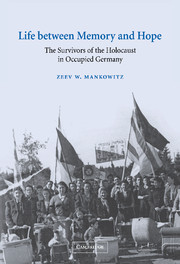Book contents
- Frontmatter
- Contents
- Plates
- Acknowledgments
- Abbreviations and note on spelling and dates
- Introduction
- 1 The occupation of Germany and the survivors: an overview
- 2 The formation of She'erith Hapleitah: November 1944 – July 1945
- 3 She'erith Hapleitah enters the international arena: July–October 1945
- 4 Hopes of Zion: September 1945 – January 1946
- 5 In search of a new politics: unity versus division
- 6 The Central Committee of the Liberated Jews in Bavaria
- 7 The politics of education
- 8 Two voices from Landsberg: Rudolf Valsonok and Samuel Gringauz
- 9 Destruction and remembrance
- 10 The survivors confront Germany
- 11 She'erith Hapleitah towards 1947
- Concluding remarks
- Bibliography
- Index
- Studies in the Social and Cultural History of Modern Warfare
9 - Destruction and remembrance
Published online by Cambridge University Press: 06 August 2009
- Frontmatter
- Contents
- Plates
- Acknowledgments
- Abbreviations and note on spelling and dates
- Introduction
- 1 The occupation of Germany and the survivors: an overview
- 2 The formation of She'erith Hapleitah: November 1944 – July 1945
- 3 She'erith Hapleitah enters the international arena: July–October 1945
- 4 Hopes of Zion: September 1945 – January 1946
- 5 In search of a new politics: unity versus division
- 6 The Central Committee of the Liberated Jews in Bavaria
- 7 The politics of education
- 8 Two voices from Landsberg: Rudolf Valsonok and Samuel Gringauz
- 9 Destruction and remembrance
- 10 The survivors confront Germany
- 11 She'erith Hapleitah towards 1947
- Concluding remarks
- Bibliography
- Index
- Studies in the Social and Cultural History of Modern Warfare
Summary
The remembrance of what had befallen the Jews of Europe was of urgent concern to She'erith Hapleitah. On one level it expressed an elementary sense of family responsibility sharpened by the lonely guilt of surviving, on another it was a conscious attempt to foil the Nazi attempt to cover up their crimes and obliterate the identity of their victims. For some, remembering was essential to learning the lessons of the past, for others it was an attempt to frustrate the inevitable inroads of human forgetfulness. “The history of humanity is rich in horror,” stated Samuel Gringauz in early 1946,
And if the annihilation of the Jewish people belongs among the most horrible events of history, still, we know – this too will be forgotten. Grass will grow where inexhaustible suffering and martyrdom were earlier enacted. Where once the mass graves were, children will play their games and the fathers will pursue their occupations. But in the hearts of Jews this question will never cease to be asked – how was it possible?
The first attempts to think comprehensively about the commemoration of the European Jewish catastrophe appeared among the surviving remnant in Germany as the first anniversary of liberation approached. The passage of time, the growing presence of repatriates who had gone through different experiences and the felt need to order commemoration brought about the first formalization of remembrance and mourning.
- Type
- Chapter
- Information
- Life between Memory and HopeThe Survivors of the Holocaust in Occupied Germany, pp. 192 - 225Publisher: Cambridge University PressPrint publication year: 2002

